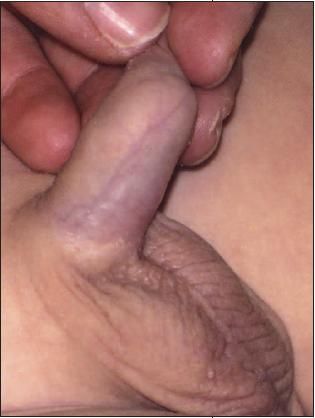A Collage of Genital Lesions, Part 2
A discussion of two types of Genital Lesions: Smegma and Torsion of the Testis.
Smegma

The mother of this 5-year-old boy was concerned about a whitish mass underneath her son's foreskin. The mass, first noted 6 months earlier, did not seem to bother the child. Urination was normal. The child was not circumcised. The mass was whitish, smooth, round, uniform, doughy, well-circumscribed, and underneath the foreskin in the midshaft of the penis.
The whitish mass is smegma- a cheesy-like material composed of desquamated epithelial cells. Smegma was once thought to be produced by sebaceous glands located within the mucosal surface of the foreskin near the frenulum. Subsequent histological examination of hundreds of foreskins has failed to find these glands.
The accumulation of smegma is simply part of the physiological retraction of the foreskin. Smegma helps to dissect the space between the glans and foreskin and also prevents readherence. In addition, smegma helps to protect and lubricate the glans and inner lamella of the prepuce.
There is some evidence that smegma may lead to genital cancer, but the subject is still very controversial. Rarely, smegma may harden to form smegma stones. Regular gentle retraction of the foreskin and meticulous genital hygiene may facilitate removal of the material.
FOR MORE INFORMATION:
? Leung AK, Wong AL. Pediatric genital disorders. Consultant for Pediatricians. 2003;2:122-130.
? Van Howe RS, Hodges FM. The carcinogenicity of smegma: debunking a myth. J Eur Acad Dermatol Venereol. 2006;20:1046-1054.

Torsion of the Testis
A 13-year-old boy presented with an acute onset of severe pain and swelling in the right side of the scrotum that began 30 minutes earlier. There was no associated fever, nausea, or vomiting. There was no history of penile discharge or trauma to the scrotum. The patient had been vaccinated against mumps at 1 year and 5 years of age.
On examination, the right testis was swollen and exquisitely tender. The cremasteric reflex was absent. There was no mass felt in the right groin area. On exploration, the right testis was engorged and hemorrhagic. The right testis was untwisted and fixed to the scrotum. A contralateral orchidopexy was also performed.
Torsion of the testis is caused by a faulty fixation of the testis to the scrotum, resulting from a redundant tunica vaginalis, which allows excessive mobility of the testis. An undescended testis is more prone to torsion than a descended one. This is because in an undescended testis, the normal scrotal attachments have not developed, and the greater relative broadness of the undescended testis relative to its mesentery makes the testis more likely to twist on the stalk. The greater mobility of a testis located in the abdomen or in the superficial inguinal pouch might also predispose to torsion. Most cases occur in the absence of any precipitating event. Approximately 4% to 8% of cases are a result of trauma.
Clinically, torsion of the testis presents with an acute onset of excruciating lower abdominal and/or scrotal pain, nausea, and vomiting. On examination, the scrotum is often erythematous on the ipsilateral side.The affected testis is exquisitely tender and appears higher. Because of the venous congestion, the affected testis may appear larger than the contralateral one. The cremasteric reflex is characteristically absent.
Torsion of the testis can be differentiated from an incarcerated inguinal hernia in that a groin mass is characteristically absent. Epididymitis usually occurs in sexually active men and is associated with urethritis and edema of the scrotal skin. Torsion of the testis also has to be differentiated from torsion of a testicular appendage. The symptoms of a torsive testicular appendage are usually less severe than those of a torsion of the testis. The torsive testicular appendage may be palpable as a tender nodule on the upper pole of the testis. At times, it can be seen through the thin scrotal skin as a pathognomonic blue dot. If the diagnosis is in doubt, a nuclear technetium scan of the testes or Doppler ultrasonography of the scrotum can be performed to assess testicular blood flow.
Torsion of the testis is a surgical emergency. If it is not treated promptly, the resulting ischemia may lead to gangrene of the testis. If the testis is still viable, it should be fixed to the scrotum once it has been untwisted. Orchidectomy should be performed if the gonad is necrotic. Contralateral orchidopexy is recommended because the faulty fixation of the testis is often bilateral.
FOR MORE INFORMATION:
? Leung AK, Wong AL. Pediatric scrotal swellings. Consultant for Pediatricians.
2003;2:172-176.
? Ringdahi E, Teague L. Testicular torsion. Am Fam Physician. 2006;74:1739-1743,
1746.
Recognize & Refer: Hemangiomas in pediatrics
July 17th 2019Contemporary Pediatrics sits down exclusively with Sheila Fallon Friedlander, MD, a professor dermatology and pediatrics, to discuss the one key condition for which she believes community pediatricians should be especially aware-hemangiomas.